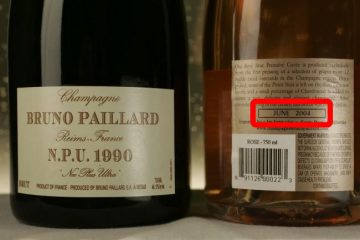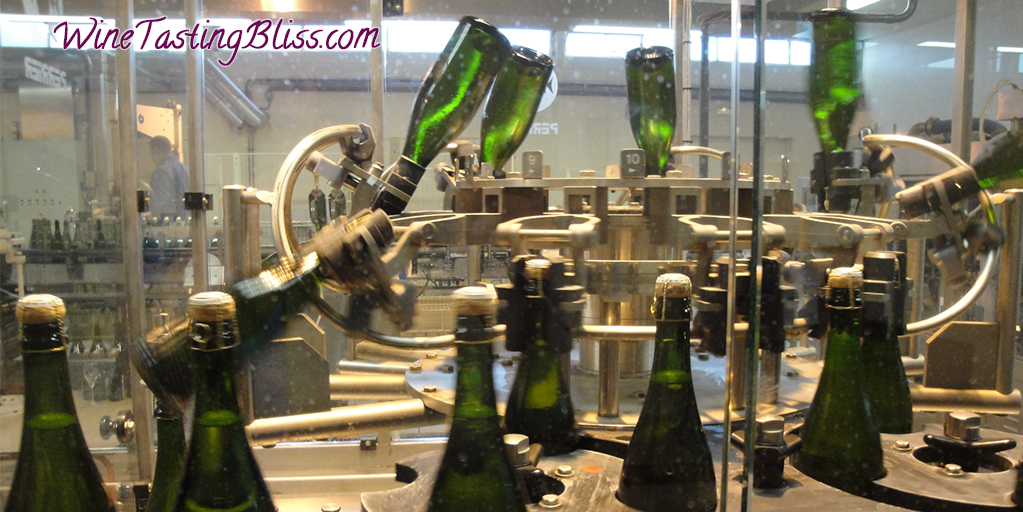The word “disgorgement” may not sound like a good thing, but to people who love champagne, the word is a favorite. So what is disgorgement and why should anyone care?
 Making champagne is a long and convoluted process. First, still wine is produced, usually from Chardonnay, Pinot Noir, Pinot Meunier, or sometimes Pinot Gris. The wine is then bottled, with yeast and sugar added. The bottle is securely sealed, usually with a metal cap similar to that used with beer bottles. For the next months or years, the bottle rests in a cool, dry environment while the yeast consumes the sugar and releases tiny bubbles of carbon dioxide.
Making champagne is a long and convoluted process. First, still wine is produced, usually from Chardonnay, Pinot Noir, Pinot Meunier, or sometimes Pinot Gris. The wine is then bottled, with yeast and sugar added. The bottle is securely sealed, usually with a metal cap similar to that used with beer bottles. For the next months or years, the bottle rests in a cool, dry environment while the yeast consumes the sugar and releases tiny bubbles of carbon dioxide.
 In addition to adding the delicious bubbles to the champagne, the yeast leaves behind some not-so-delicious sediment. Removing this sediment takes time and care, and that is where disgorgement comes in. First, the sediment is gently coaxed up into the neck of the bottle through a process called riddling. Riddling is done by rotating and tilting each bottle over a period of weeks (or days if done by a gyro-pallet, as in this image).
In addition to adding the delicious bubbles to the champagne, the yeast leaves behind some not-so-delicious sediment. Removing this sediment takes time and care, and that is where disgorgement comes in. First, the sediment is gently coaxed up into the neck of the bottle through a process called riddling. Riddling is done by rotating and tilting each bottle over a period of weeks (or days if done by a gyro-pallet, as in this image).
 Once the sediment is at the top of the bottle, it must be removed. That is called disgorgement. The neck of the bottle is submerged in a glycol bath that is chilled well below the freezing point of champagne. The causes the champagne in the neck containing the sediment to freeze. Once frozen, the metal cap is removed, whereupon the ice plug is ejected from the pressure in the bottle, along with a bit of champagne. The lost wine is replaced, along with an optional bit of sugar. This is called the dosage. The bottle is ready for a cork and a label. After a period of additional aging, it is now ready for sale as champagne.
Once the sediment is at the top of the bottle, it must be removed. That is called disgorgement. The neck of the bottle is submerged in a glycol bath that is chilled well below the freezing point of champagne. The causes the champagne in the neck containing the sediment to freeze. Once frozen, the metal cap is removed, whereupon the ice plug is ejected from the pressure in the bottle, along with a bit of champagne. The lost wine is replaced, along with an optional bit of sugar. This is called the dosage. The bottle is ready for a cork and a label. After a period of additional aging, it is now ready for sale as champagne.
Upon disgorgement, the chemical interactions in the bottle change dramatically. After months or years aging without any oxygen, the disgorgement briefly blasts oxygen into the bottle. The impervious metal bottle cap is replaced with a cork, which is somewhat porous to oxygen. That means that champagne really has two aging periods: one while it is “on the lees” and the second starting on the disgorgement date and running until the bottle is opened.
 As champagne lovers learn about all of the facets of fine champagne, they have become more discerning. As a result, many champagne houses now print the disgorgement date on the label. In other cases, one must decode the disgorgement date from a lot number printed on the foil over the cork. This date can help select champagne that matches each palate. For the first few years after disgorgement, the champagne will lead with citrus notes. After more time post-disgorgement, notes of toast and oak start to peek out.
As champagne lovers learn about all of the facets of fine champagne, they have become more discerning. As a result, many champagne houses now print the disgorgement date on the label. In other cases, one must decode the disgorgement date from a lot number printed on the foil over the cork. This date can help select champagne that matches each palate. For the first few years after disgorgement, the champagne will lead with citrus notes. After more time post-disgorgement, notes of toast and oak start to peek out.
So next time you are out for a champagne tasting, drop a little wisdom on the crowd. Ask about the disgorgement date and how the champagne has been tasting since it has been released. Even non-vintage champagne has a birth date!
About the Author: John grills a mean steak and is always in the market for another wine fridge. Believes that if a winery has more than 10 employees, it's probably too big. Buys wine faster than he drinks it, but who cares?


